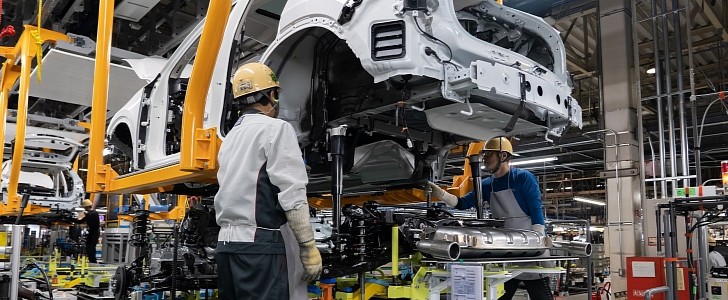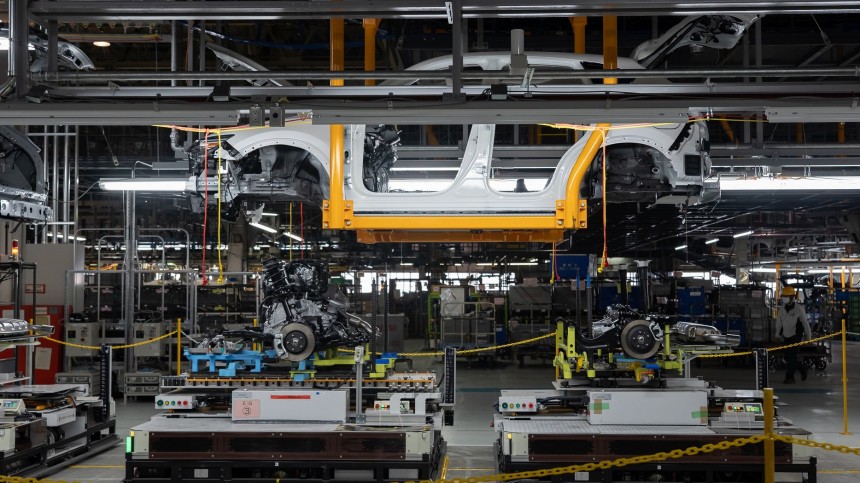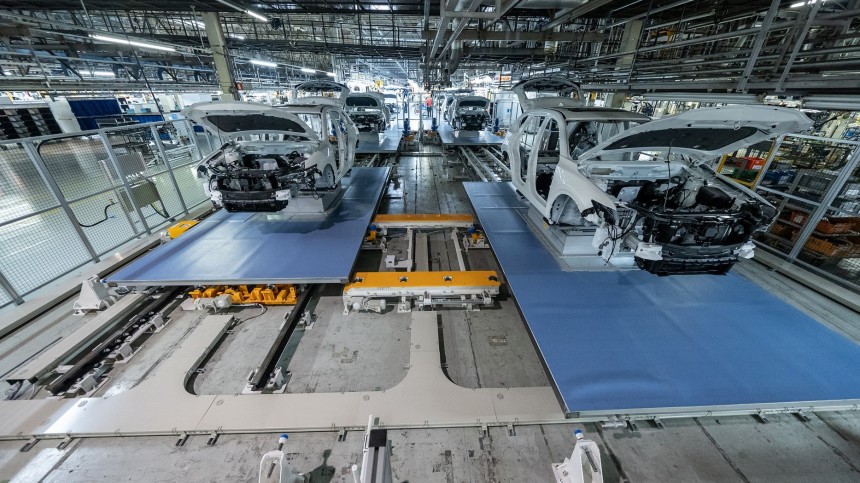Mazda announced today it would offer a more extensive variety of SUVs in all markets: the CX-60, CX-70, CX-80, and CX-90. It also promised the plug-in hybrid version of the MX-30 for the first half of 2022. What all that will allow it to achieve is a flexible production system, as revealed by Automotive News. In any scenario, that sounds like a competitive advantage, but with the EV shift, it is also a way to stay alive if it makes the wrong bets.
Mazda’s new production system is based on the so-called Traverse Dolly Line, combined with AGV (automatic guided vehicles). The traverse dollies replace fixed conveyors and hangers and count on flat palettes platforms that follow them. Summing up, this new production method killed most fixed structures.
With this acquired flexibility, Mazda can extend the line or retool it for a new vehicle in much less time than it did before. When it comes to retooling, the Japanese carmaker reduced the time necessary for that by 80%, while the investment in that change is 90% lower. If we were talking about extending a line, the company would spend a week instead of six in the process.
Apart from the manufacturing benefits, the new system will also impact the well-being of workers, who will no longer risk stepping on conveyors or dodge hangers in the production process. Mazda told Automotive News that making things easier for them helped increase productivity by 25%.
The first factory to adopt the new production technologies was Hofu, but all Mazda facilities are supposed to do the same. When it comes to the new Mazda Toyota Manufacturing in Huntsville, Alabama, using the system would imply sharing the benefits with Toyota. Mazda may make some money if the idea is patented: licensing it to one of the biggest carmakers in the world would ensure an additional revenue stream.
This “rootless” approach gave the Japanese the flexibility it will need in case demand for electric cars increases or if it is forced to sell them all of a sudden, which is something Mazda showed it would not accept without some resistance.
The company presented the MX-30 as its first mass-produced electric vehicle, but that is not true. The MX-30 is a vehicle that can be powered solely by electric motors and fed by a battery pack, but its range limitations frame it as a compliance car. It is for Mazda as the Ioniq is for Hyundai with its multiple versions: BEV, HEV, and PHEV. And that’s an approach it tends to have with all its future cars.
With vehicles that can present any grade of electrification, Mazda will be able to manufacture whichever version has more demand. The problem is that all of its versions will have compromises that tend to make the brand be ignored by customers willing to have an electric car. In other words, having an EV to sell does not equate to having customers craving to buy them.
If Mazda simply added its rotary engine to the current electric MX-30, it would make it one of the best plug-in hybrids in the market, with one of the longest ranges of them all. However, the company already said it would reduce the size of the battery pack. It says that will make it lighter, but the real explanation seems to be that it will be cheaper to build.
We’ll confirm that in the first quarter of 2022. Although we hope to be pleasantly surprised with a different strategy (giving the current electric MX-30 the rotary engine), it is improbable to happen. As flexible and agile as Mazda may now be, that may not save it from poor decisions regarding new products: it will only make them less damaging. What the company really needs is a convincing electric vehicle. New technologies, such as solid-state batteries, may help it get there.
With this acquired flexibility, Mazda can extend the line or retool it for a new vehicle in much less time than it did before. When it comes to retooling, the Japanese carmaker reduced the time necessary for that by 80%, while the investment in that change is 90% lower. If we were talking about extending a line, the company would spend a week instead of six in the process.
Apart from the manufacturing benefits, the new system will also impact the well-being of workers, who will no longer risk stepping on conveyors or dodge hangers in the production process. Mazda told Automotive News that making things easier for them helped increase productivity by 25%.
This “rootless” approach gave the Japanese the flexibility it will need in case demand for electric cars increases or if it is forced to sell them all of a sudden, which is something Mazda showed it would not accept without some resistance.
The company presented the MX-30 as its first mass-produced electric vehicle, but that is not true. The MX-30 is a vehicle that can be powered solely by electric motors and fed by a battery pack, but its range limitations frame it as a compliance car. It is for Mazda as the Ioniq is for Hyundai with its multiple versions: BEV, HEV, and PHEV. And that’s an approach it tends to have with all its future cars.
If Mazda simply added its rotary engine to the current electric MX-30, it would make it one of the best plug-in hybrids in the market, with one of the longest ranges of them all. However, the company already said it would reduce the size of the battery pack. It says that will make it lighter, but the real explanation seems to be that it will be cheaper to build.
We’ll confirm that in the first quarter of 2022. Although we hope to be pleasantly surprised with a different strategy (giving the current electric MX-30 the rotary engine), it is improbable to happen. As flexible and agile as Mazda may now be, that may not save it from poor decisions regarding new products: it will only make them less damaging. What the company really needs is a convincing electric vehicle. New technologies, such as solid-state batteries, may help it get there.














